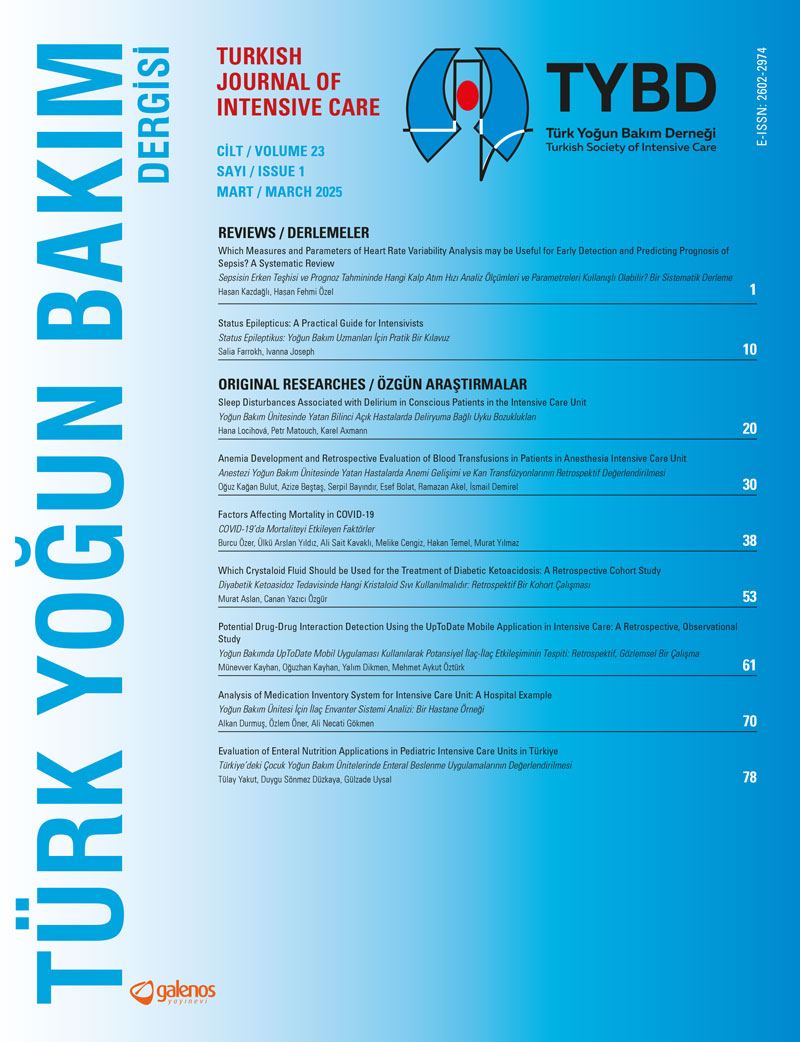Öz
Sepsis, kardiyovasküler, solunum ve termoregülasyon gibi sistemlerde patolojik değişikliklere neden olur. Bu değişiklikler de kalp hızı değişkenliğinde (HRV) alterasyonlara neden olur. Vital bulgularda veya hastalığın klinik sunumunda herhangi bir değişiklik olmasa bile, enfeksiyona bağlı olarak sempatik sinir sistemi aktivasyonu nedeniyle HRV parametreleri değişebilir. Bu sistematik derlemedeki amacımız, literatürü inceleyerek sepsise ilişkin HRV ölçümlerini ve parametrelerini sunmak ve bunların sepsisin şiddetini ve ölüm riskini tahmin etmedeki olası rolünü araştırmaktır.
Veritabanları, Nisan 1996 - Mayıs 2023 tarihleri arasında İngilizce dilinde yayınlanmış sepsis üzerine HRV analizlerini insan çalışmalarını bildiren orijinal araştırma makaleleri için tarandı. Makale araması tamamlandıktan sonra, 79 makale daha ayrıntılı bir değerlendirmeye tabi tutulmak üzere seçildi ve bu makalelerin tam metinleri incelendikten sonra 13 makale kriterlere uygun olarak sınıflandırıldı. Her HRV parametrelerinin ortalama değerleri her çalışmanın örnek büyüklüğüne göre düzeltildi ve genel ortalamalar hesaplandı. İstatistiksel karşılaştırmalar Wilcoxon eşleştirilmiş diziler testi ile yapıldı. Toplam 1453 hastanın yer aldığı dokuz çalışma dahil edildi, ortalama yaş 64,24 yıl ve tüm katılımcıların %53,9’u erkekti. Dahil edilen çalışmaların hepsi zaman, frekans domain analizi gerçekleştirdi ve dört tanesi bu analizlere ek olarak doğrusal olmayan analizler gerçekleştirdi. Dokuz çalışmanın yedisini acil serviste ve ikisini hastanelerin yoğun bakım ünitelerinde gerçekleştirildi. Altı çalışma sağ kalanlar ile hayatını kaybedenler arasındaki parametreleri, üç çalışma ise sepsisin farklı şiddet seviyeleri arasındaki parametreleri karşılaştırdı. SDNN, RMSSD, SDNN, HTI, LFnu, HFnu, LF/HF oranı, SD1, SD2, eğilimsiz dalgalanma analizi (DFA)α1 ve DFAα2, sepsis sonucuyla ilişkili gibi görünmektedir. Bu nedenle, sepsisin erken teşhisi için bu parametrelerin izlenmesinin faydalı olabilir.
Anahtar Kelimeler: Sepsis, kalp atım hızı değişkenliği, zaman tabanlı parametreler, frekans tabanlı parametreler, doğrusal olmayan analizler
Referanslar
- Minasyan H. Sepsis and septic shock: Pathogenesis and treatment perspectives. J Crit Care. 2017;40:229-42.
- Carrara M, Ferrario M, Bollen Pinto B, Herpain A. The autonomic nervous system in septic shock and its role as a future therapeutic target: a narrative review. Ann Intensive Care. 2021;11:80.
- Akalin H. Sepsis: tanimlar, tani, etyoloji ve epidemiyolijide yeni gelismeler. J Turk Soc Intens Care. 2007;5.
- Annane D, Trabold F, Sharshar T, Jarrin I, Blanc AS, Raphael JC, et al. Inappropriate sympathetic activation at onset of septic shock: a spectral analysis approach. Am J Respir Crit Care Med. 1999;160:458-65.
- Heart rate variability: standards of measurement, physiological interpretation and clinical use. Task Force of the European Society of Cardiology and the North American Society of Pacing and Electrophysiology. Circulation. 1996;93:1043-65.
- Shaffer F, Ginsberg JP. An overview of heart rate variability metrics and norms. Front Public Health. 2017;5:258.
- Heathers JA. Everything Hertz: methodological issues in short-term frequency-domain HRV. Front Physiol. 2014;5:177.
- Billman GE. The LF/HF ratio does not accurately measure cardiac sympatho-vagal balance. Front Physiol. 2013;4:26.
- Halyabar O, Chang MH, Schoettler ML, Schwartz MA, Baris EH, Benson LA, et al. Calm in the midst of cytokine storm: a collaborative approach to the diagnosis and treatment of hemophagocytic lymphohistiocytosis and macrophage activation syndrome. Pediatr Rheumatol. 2019;17:7.
- Chao J, Cui S, Liu C, Liu S, Liu S, Han Y, et al. Detection of early cytokine storm in patients with septic shock after abdominal surgery. J Transl Intern Med. 2020;8:91-8.
- Rivers E, Nguyen B, Havstad S, Ressler J, Muzzin A, Knoblich B, et al. Early goal-directed therapy in the treatment of severe sepsis and septic shock. N Engl J Med. 2001;345:1368-77.
- Hasty F, García G, Dávila H, Wittels SH, Hendricks S, Chong S. Heart rate variability as a possible predictive marker for acute inflammatory response in COVID-19 patients. Mil Med. 2021;186:e34-8.
- Griffin MP, Moorman JR. Toward the early diagnosis of neonatal sepsis and sepsis-like illness using novel heart rate analysis. Pediatrics. 2001;107:97-104.
- Barnaby D, Ferrick K, Kaplan DT, Shah S, Bijur P, Gallagher EJ. Heart rate variability in emergency department patients with sepsis. Acad Emerg Med. 2002;9:661-70.
- Limongelli G, Miele T, Pacileo G, Di Salvo G, Calabro’ P, Ancona R, et al. Heart rate variability is a weak predictor of sudden death in children and young patients with hypertrophic cardiomyopathy. Heart. 2007;93:117-8.
- Terathongkum S, Pickler RH. Relationships among heart rate variability, hypertension, and relaxation techniques. J Vasc Nurs. 2004;22:78-82; quiz 83-4.
- Larosa C, Sgueglia GA, Sestito A, Infusino F, Niccoli G, Lamendola P, et al. Predictors of impaired heart rate variability and clinical outcome in patients with acute myocardial infarction treated by primary angioplasty. J Cardiovasc Med (Hagerstown). 2008;9:76-80.
- Furuland H, Linde T, Englund A, Wikström B. Heart rate variability is decreased in chronic kidney disease but may improve with hemoglobin normalization. J Nephrol. 2008;21:45-52.
- Shaffer F, McCraty R, Zerr CL. A healthy heart is not a metronome: an integrative review of the heart’s anatomy and heart rate variability. Front Psychol. 2014;5:1040.
- Otsuka K, Oinuma S, Cornélissen G, Weydahl A, Ichimaru Y, Kobayashi M, et al. Alternating light-darkness-influenced human electrocardiographic magnetoreception in association with geomagnetic pulsations. Biomed. Pharmacother. 2000;55:63-75.
- Armour, JA. Neurocardiology. Anatomical and Functional Principles. Boulder Creek, CA: HeartMath Research Center, Institute of HeartMath, Publication, 2003, 03-011.
- Kember GC, Fenton GA, Collier K, Armour JA. Aperiodic stochastic resonance in a hysteretic population of cardiac neurons. Phys Rev E. 2000;61:1816.
- McCraty R, Shaffer F. Heart rate variability: new perspectives on physiological mechanisms, assessment of self-regulatory capacity, and health risk. Glob Adv Health Med. 2015;4:46-61.
- Akselrod S, Gordon D, Ubel FA, Shannon DC, Berger AC, Cohen RJ. Power spectrum analysis of heart rate fluctuation: a quantitative probe of beat-to-beat cardiovascular control. Science. 1981;213:220-2.
- Berntson GG, Cacioppo JT, Grossman P. Whither vagal tone. Biol Psychol. 2007;74:295-300.
- Lehrer PM. Principles and practice of stress management: advances in the field. Biofeedback; Lawrence. 2007;35:82-4.
- Benichou T, Pereira B, Mermillod M, Tauveron I, Pfabigan D, Maqdasy S, et al. Heart rate variability in type 2 diabetes mellitus: A systematic review and meta-analysis. PLoS One. 2018;13:e0195166.
- Kazdagli H, Ozel HF, Ozturk S, Ceylan D, Erdeniz B, Ozbek M, Semin MI. Electrophysiological detection of exam stress in health schools’ students. Physiol Int. 2024;111:222-41.
- Goldberger AL. Fractal variability versus pathologic periodicity: complexity loss and stereotypy in disease. Perspect Biol Med. 1997;40:543-61.
- Young HA, Benton D. Heart-rate variability: a biomarker to study the influence of nutrition on physiological and psychological health? Behav Pharmacol. 2018;29:140-51.
- Hsu CH, Tsai MY, Huang GS, Lin TC, Chen KP, Ho ST, et al. Poincaré plot indexes of heart rate variability detect dynamic autonomic modulation during general anesthesia induction. Acta Anaesthesiol Taiwan. 2012;50:12-8.
- Ozel HF, Kazdagli H. A simple approach to determine loss of physiological complexity in heart rate series. Biomed Phys Eng Express. 2023;9.
- Weippert M, Behrens K, Rieger A, Kumar M, Behrens M. Effects of breathing patterns and light exercise on linear and nonlinear heart rate variability. Appl Physiol Nutr Metab. 2015;40:762-8.
- Arbo JE, Lessing JK, Ford WJH, Clark S, Finkelsztein E, Schenck EJ, et al. Heart rate variability measures for prediction of severity of illness and poor outcome in ED patients with sepsis. Am J Emerg Med. 2020;38:2607-13.
- Bonjorno Junior JC, Caruso FR, Mendes RG, da Silva TR, Biazon TMPC, Rangel F, et al. Noninvasive measurements of hemodynamic, autonomic and endothelial function as predictors of mortality in sepsis: A prospective cohort study. PLoS One. 2019;14:e0213239.
- Chen WL, Chen JH, Huang CC, Kuo CD, Huang CI, Lee LS. Heart rate variability measures as predictors of in-hospital mortality in ED patients with sepsis. Am J Emerg Med. 2008;26:395-401.
- Kim JY, Yoon YH, Park SM, Choi SH, Cho YD, Hong YS. Heart rate variability measurement in sepsis patients. Hong Kong J Emerg Med. 2014;21:73-9.
- Papaioannou VE, Dragoumanis C, Theodorou V, Gargaretas C, Pneumatikos I. Relation of heart rate variability to serum levels of C-reactive protein, interleukin 6, and 10 in patients with sepsis and septic shock. J Crit Care. 2009;24:625.e1-7.
- Pong JZ, Fook-Chong S, Koh ZX, Samsudin MI, Tagami T, Chiew CJ, et al. Combining heart rate variability with disease severity score variables for mortality risk stratification in septic patients presenting at the emergency department. Int J Environ Res Public Health. 2019;16:1725.
- Prabhakar SM, Tagami T, Liu N, Samsudin MI, Ng JCJ, Koh ZX, Ong MEH. Combining quick sequential organ failure assessment score with heart rate variability may improve predictive ability for mortality in septic patients at the emergency department. PLoS One. 2019;14:e0213445.
- Samsudin MI, Liu N, Prabhakar SM, Chong SL, Kit Lye W, Koh ZX, Guo D, Rajesh R, Ho AFW, Ong MEH. A novel heart rate variability based risk prediction model for septic patients presenting to the emergency department. Medicine (Baltimore). 2018;97:e10866.
- Tang CH, Chan GS, Middleton PM, Savkin AV, Lovell NH. Spectral analysis of heart period and pulse transit time derived from electrocardiogram and photoplethysmogram in sepsis patients. Annu Int Conf IEEE Eng Med Biol Soc. 2009;2009:1781-4.
- Ulloa L. The vagus nerve and the nicotinic anti-inflammatory pathway. Nat Rev Drug Discov. 2005;4:673-84.
- Waldburger JM, Boyle DL, Pavlov VA, Tracey KJ, Firestein GS. Acetylcholine regulation of synoviocyte cytokine expression by the alpha7 nicotinic receptor. Arthritis Rheum. 2008;58:3439-49.
- Natarajan A, Su HW, Heneghan C. Assessment of physiological signs associated with COVID-19 measured using wearable devices. Npj Digit. Med., 2020;3:156.
- Aragón-Benedí C, Oliver-Forniés P, Galluccio F, Yamak Altinpulluk E, Ergonenc T, El Sayed Allam A, et al. Is the heart rate variability monitoring using the analgesia nociception index a predictor of illness severity and mortality in critically ill patients with COVID-19? A pilot study. PLoS One. 2021;16:e0249128.
- Krishnan P, Marshall C, Yang P, Bhavani SV, Holder A, Esper A, et al. Autonomic dysfunction characterized by heart rate variability among patients with sepsis-related acute respiratory failure. medRxiv. 2021;2021-11.
- Kenig A, Ilan Y. A personalized signature and chronotherapy-based platform for improving the efficacy of sepsis treatment. Front Physiol. 2019;10:1542.
- Otake Y, Kobayashi T, Hakozaki Y, Matsui T. Non-contact heart rate variability monitoring using Doppler radars located beneath bed mattress: a case report. Eur Heart J Case Rep. 2021;5:ytab273.
- Jarkovska D, Valesova L, Chvojka J, Benes J, Danihel V, Sviglerova J, et al. Heart-rate variability depression in porcine peritonitis-induced sepsis without organ failure. Exp Biol Med (Maywood). 2017;242:1005-12.
- Brown SM, Tate Q, Jones JP, Knox DB, Kuttler KG, Lanspa M, et al. Initial fractal exponent of heart rate variability is associated with success of early resuscitation in patients with severe sepsis or septic shock: a prospective cohort study. J Crit Care. 2013;28:959-63.
- Ahmad S, Ramsay T, Huebsch L, Flanagan S, McDiarmid S, Batkin I, et al. Continuous multi-parameter heart rate variability analysis heralds onset of sepsis in adults. PLoS One. 2009;4:e6642.
Telif hakkı ve lisans
Telif hakkı © 2025 Yazar(lar). Açık erişimli bu makale, orijinal çalışmaya uygun şekilde atıfta bulunulması koşuluyla, herhangi bir ortamda veya formatta sınırsız kullanım, dağıtım ve çoğaltmaya izin veren Creative Commons Attribution License (CC BY) altında dağıtılmıştır.






















